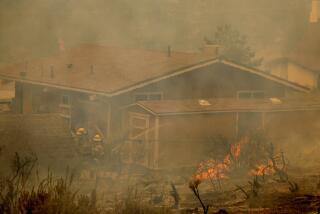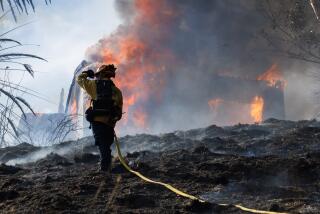Smoldering Hazard Lurks in Old Attics : * Anaheim Must Insist on Fire Safety Improvements
Anaheim recognized in the early 1980s the fire hazard posed by the construction of common attics in apartment complexes. The city outlawed the practice. But even though fire walls now separate units in newer construction, and sensibly are included in the updated city building code, many structures predate the ordinance.
This allows for the very kind of fire that the city consciously has taken steps to prevent in newer buildings.
Indeed, just such a blaze occurred last month, when an electrical fire spread through the attics of three apartment buildings, destroying 24 units at La Ramada Apartments.
Luckily, there were no injuries to residents, but five firefighters were hospitalized for smoke inhalation, heat exhaustion or burns.
In all, about 60 residents were routed from their homes--no small inconvenience. And there was considerable property damage too; the initial estimate was put at more than $1.7 million.
The new regulations were not in place early enough to anticipate Anaheim’s remarkable growth, and the city is not unique in having this problem. Some of the older parts of the county, such as Tustin, Placentia and Stanton, have buildings that require constant monitoring by the Orange County Fire Department.
But Anaheim, with only its own Fire Department and its City Council to deal with, ought to resolve that even one attic fire is one too many. Indeed, a similar fire nearly six years ago caused $2.5 million in damage and led to a ban on fireworks after stray fireworks ignited wood shingles at the Casa de Valencia Apartments.
The county Fire Department, which provides fire protection for 16 cities as well as unincorporated areas, has a far more complicated task than any one city in attacking such a problem. It has to work with a host of city officials responsible for many different fire and building codes, and with a geographically diverse business community.
And yet the county has resolved that public safety is so important that it will work patiently but firmly to help business owners improve the fire safety in such older buildings--mindful that safety improvements can be expensive and therefore a tough sell politically.
The county approach is to offer several options or a combination of them--whether it be fire walls, sprinkler systems, additional exits--whatever the owner can do within a reasonable budget. The county thus has shown that improvements can be made with due consideration to the burdensome cost to owners of buildings or businesses.
Anaheim has its own inspection program, but it should not be bashful about insisting that more be done to improve the safety of the older attics. Building owners can be enlisted to do their own monitoring. The fire marshal can extract a commitment from the City Council to begin requiring building owners to make improvements at reasonable cost and over a reasonable period of time.
Surely, by the time the firefighters arrive at a spreading attic fire, it is too late to do anything preventive or to save money. Such fires build up undetected and run the length of the roof, out of sight before exploding.
No wonder interim fire marshal Michael Doty says emphatically: “Attic fires are always a nightmare.”
Apartment dwellers were fortunate this time, because of alert neighbors such as Wade Lockett. The former Raiders football player ran from door to door making sure everyone was out of his building. His pounding on doors saved lives.
But it should not have to come to that. Anaheim must do better.
More to Read
Sign up for Essential California
The most important California stories and recommendations in your inbox every morning.
You may occasionally receive promotional content from the Los Angeles Times.










